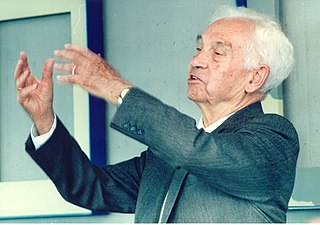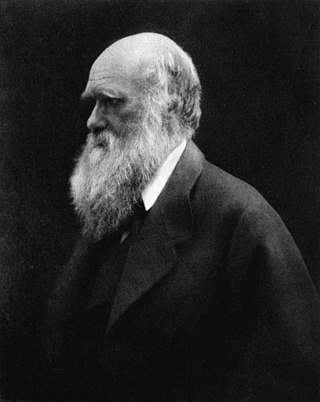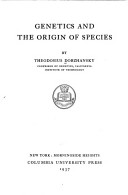Related Research Articles

Ernst Walter Mayr was one of the 20th century's leading evolutionary biologists. He was also a renowned taxonomist, tropical explorer, ornithologist, philosopher of biology, and historian of science. His work contributed to the conceptual revolution that led to the modern evolutionary synthesis of Mendelian genetics, systematics, and Darwinian evolution, and to the development of the biological species concept.

John Maynard Smith was a British theoretical and mathematical evolutionary biologist and geneticist. Originally an aeronautical engineer during the Second World War, he took a second degree in genetics under the well-known biologist J. B. S. Haldane. Maynard Smith was instrumental in the application of game theory to evolution with George R. Price, and theorised on other problems such as the evolution of sex and signalling theory.

In evolutionary biology, punctuated equilibrium is a theory that proposes that once a species appears in the fossil record, the population will become stable, showing little evolutionary change for most of its geological history. This state of little or no morphological change is called stasis. When significant evolutionary change occurs, the theory proposes that it is generally restricted to rare and geologically rapid events of branching speciation called cladogenesis. Cladogenesis is the process by which a species splits into two distinct species, rather than one species gradually transforming into another.

The modern synthesis was the early 20th-century synthesis of Charles Darwin's theory of evolution and Gregor Mendel's ideas on heredity into a joint mathematical framework. Julian Huxley coined the term in his 1942 book, Evolution: The Modern Synthesis.

Evolutionary biology is the subfield of biology that studies the evolutionary processes that produced the diversity of life on Earth. It is also defined as the study of the history of life forms on Earth. Evolution holds that all species are related and gradually change over generations. In a population, the genetic variations affect the phenotypes of an organism. These changes in the phenotypes will be an advantage to some organisms, which will then be passed onto their offspring. Some examples of evolution in species over many generations are the peppered moth and flightless birds. In the 1930s, the discipline of evolutionary biology emerged through what Julian Huxley called the modern synthesis of understanding, from previously unrelated fields of biological research, such as genetics and ecology, systematics, and paleontology.

Evolution: International Journal of Organic Evolution, is a monthly scientific journal that publishes significant new results of empirical or theoretical investigations concerning facts, processes, mechanics, or concepts of evolutionary phenomena and events. Evolution is published by Oxford Academic for the Society for the Study of Evolution. Its current editor-in-chief is Tracey Chapman of the University of East Anglia, United Kingdom.
The European Society for Evolutionary Biology (ESEB) was founded in 1987 in Basel (Switzerland) with around 450 evolutionary biologists attending the inaugural congress. It is an academic society that brings together more than 1500 evolutionary biologists from across Europe and beyond. The founding of the society was closely linked with the launch of the society's journal, the Journal of Evolutionary Biology with the first issue appearing in 1988. ESEB aims at supporting the study of evolution. Beside publishing the journal and co-publishing Evolution Letters, the society organises a biannual congress and supports other events to promote advances in evolutionary biology. ESEB also supports activities to promote a scientific view of evolution in research and education.

This is a list of topics in evolutionary biology.

Orthogenesis, also known as orthogenetic evolution, progressive evolution, evolutionary progress, or progressionism, is an obsolete biological hypothesis that organisms have an innate tendency to evolve in a definite direction towards some goal (teleology) due to some internal mechanism or "driving force". According to the theory, the largest-scale trends in evolution have an absolute goal such as increasing biological complexity. Prominent historical figures who have championed some form of evolutionary progress include Jean-Baptiste Lamarck, Pierre Teilhard de Chardin, and Henri Bergson.

Genetics and the Origin of Species is a 1937 book by the Ukrainian-American evolutionary biologist Theodosius Dobzhansky. It is regarded as one of the most important works of the modern synthesis, and was one of the earliest. The book popularized the work of population genetics to other biologists, and influenced their appreciation for the genetic basis of evolution. In his book, Dobzhansky applied the theoretical work of Sewall Wright (1889–1988) to the study of natural populations, allowing him to address evolutionary problems in a novel way during his time. Dobzhansky implements theories of mutation, natural selection, and speciation throughout his book to explain habits of populations and the resulting effects on their genetic behavior. The book explains evolution in depth as a process over time that accounts for the diversity of all life on Earth. The study of evolution was present, but greatly neglected at the time. Dobzhansky illustrates that evolution regarding the origin and nature of species during this time in history was deemed mysterious, but had expanding potential for progress to be made in its field.

George Ledyard Stebbins Jr. was an American botanist and geneticist who is widely regarded as one of the leading evolutionary biologists of the 20th century. Stebbins received his Ph.D. in botany from Harvard University in 1931. He went on to the University of California, Berkeley, where his work with E. B. Babcock on the genetic evolution of plant species, and his association with a group of evolutionary biologists known as the Bay Area Biosystematists, led him to develop a comprehensive synthesis of plant evolution incorporating genetics.
Systematics and the Origin of Species from the Viewpoint of a Zoologist is a book written by zoologist and evolutionary biologist Ernst Mayr, first published in 1942 by Columbia University Press. The book became one of the canonical publications on the modern synthesis and is considered to be exemplary of the original expansion of evolutionary theory. The book is considered one of his greatest and most influential.

Many scientists and philosophers of science have described evolution as fact and theory, a phrase which was used as the title of an article by paleontologist Stephen Jay Gould in 1981. He describes fact in science as meaning data, not known with absolute certainty but "confirmed to such a degree that it would be perverse to withhold provisional assent". A scientific theory is a well-substantiated explanation of such facts. The facts of evolution come from observational evidence of current processes, from imperfections in organisms recording historical common descent, and from transitions in the fossil record. Theories of evolution provide a provisional explanation for these facts.
The species problem is the set of questions that arises when biologists attempt to define what a species is. Such a definition is called a species concept; there are at least 26 recognized species concepts. A species concept that works well for sexually reproducing organisms such as birds may be useless for species that reproduce asexually, such as bacteria. The scientific study of the species problem has been called microtaxonomy.

The history of molecular evolution starts in the early 20th century with "comparative biochemistry", but the field of molecular evolution came into its own in the 1960s and 1970s, following the rise of molecular biology. The advent of protein sequencing allowed molecular biologists to create phylogenies based on sequence comparison, and to use the differences between homologous sequences as a molecular clock to estimate the time since the last common ancestor. In the late 1960s, the neutral theory of molecular evolution provided a theoretical basis for the molecular clock, though both the clock and the neutral theory were controversial, since most evolutionary biologists held strongly to panselectionism, with natural selection as the only important cause of evolutionary change. After the 1970s, nucleic acid sequencing allowed molecular evolution to reach beyond proteins to highly conserved ribosomal RNA sequences, the foundation of a reconceptualization of the early history of life.
In biology, a species is the basic unit of classification and a taxonomic rank of an organism, as well as a unit of biodiversity. A species is often defined as the largest group of organisms in which any two individuals of the appropriate sexes or mating types can produce fertile offspring, typically by sexual reproduction. Other ways of defining species include their karyotype, DNA sequence, morphology, behaviour or ecological niche. In addition, paleontologists use the concept of the chronospecies since fossil reproduction cannot be examined.
Jody Hey is an evolutionary biologist at Temple University. In the 1980s and 1990s he did research on natural selection and species divergence in fruit flies (Drosophila). More recently he has worked on the development of methods for studying evolutionary divergence, on the divergence of cichlid fishes from Lake Malawi, on chimpanzees and on human populations. His research on divergence and speciation also lead him to study the difficulties of identifying species.
Joe Cain is a historian of science who specialises in the history of evolutionary biology. He is currently Professor of History and Philosophy of Biology at University College London, and from 2011 to 2019 he was Head of Department of UCL's Department of Science and Technology Studies. He was also editor of BSHS Monographs, a series published by the British Society for the History of Science.

The following outline is provided as an overview of and topical guide to evolution:

The scientific study of speciation — how species evolve to become new species — began around the time of Charles Darwin in the middle of the 19th century. Many naturalists at the time recognized the relationship between biogeography and the evolution of species. The 20th century saw the growth of the field of speciation, with major contributors such as Ernst Mayr researching and documenting species' geographic patterns and relationships. The field grew in prominence with the modern evolutionary synthesis in the early part of that century. Since then, research on speciation has expanded immensely.
References
- ↑ Cain, Joseph. 1994. Ernst Mayr as community architect: launching the Society for the Study of Evolution and the journal Evolution. Biology and Philosophy9: 387–427; Cain, Joe. 2000. For the 'promotion' and 'integration' of various fields: first years of Evolution, 1947-1949. Archives of Natural History27: 231–259.
- ↑ Cain, Joe, ed. 2004. Exploring the borderlands: documents of the Committee on Common Problems of Genetics, Paleontology, and Systematics, 1943–1944. Transactions of the American Philosophical Society. 94: xlii + 160; Cain, Joe. 2002. Epistemic and community transition in American evolutionary studies: the 'Committee on Common Problems of Genetics, Paleontology, and Systematics' (1942–1949). Studies in History and Philosophy of Biological and Biomedical Sciences. 33: 283–313.
- ↑ Evolution journal official website at Oxford Academic.
- ↑ "Evolution". Wiley Online Library. John Wiley & Sons, Inc. Retrieved 31 July 2015.
- ↑ Evolution Letters official website at Oxford Academic.
- ↑ "Evolution Letters - Wiley Online Library".